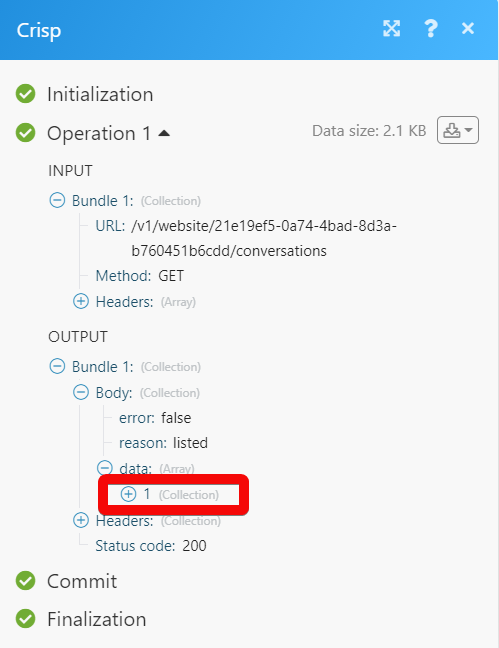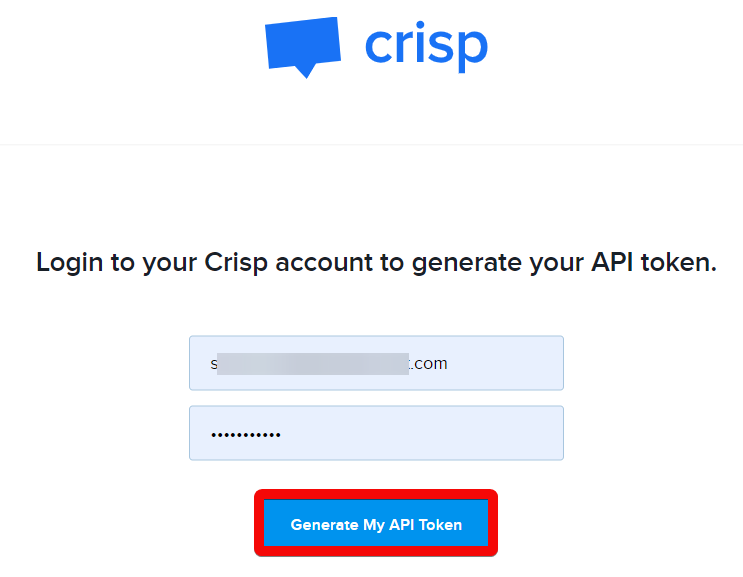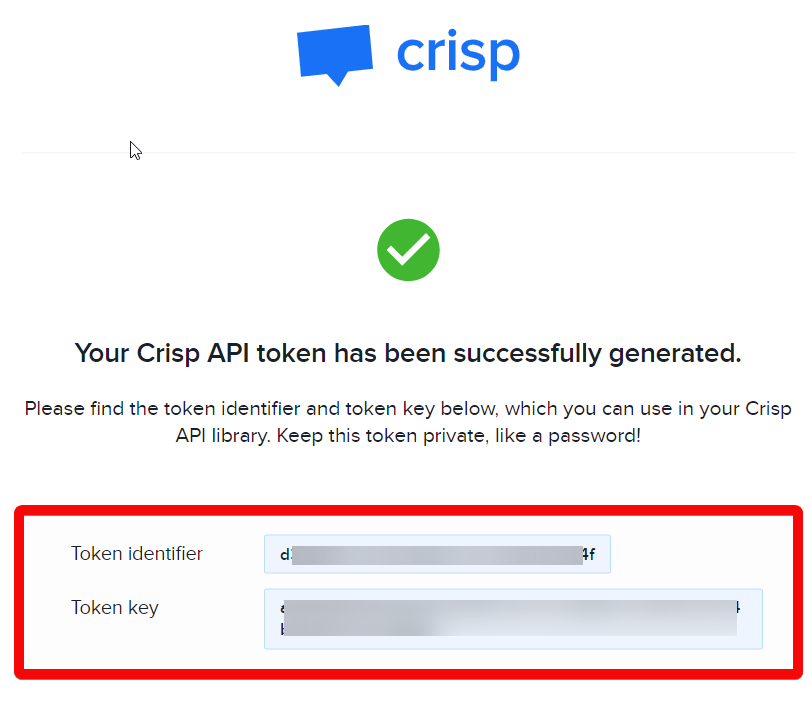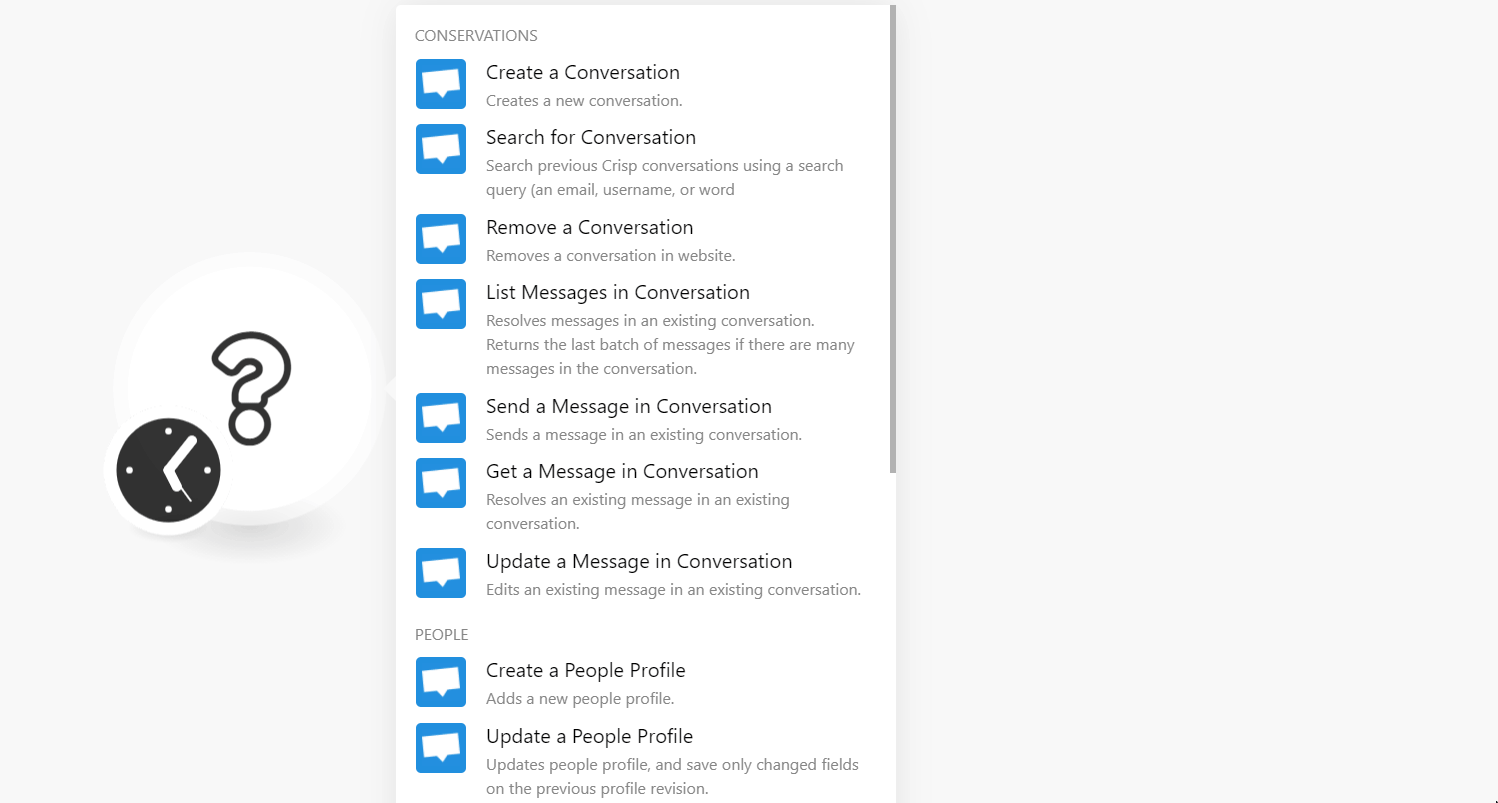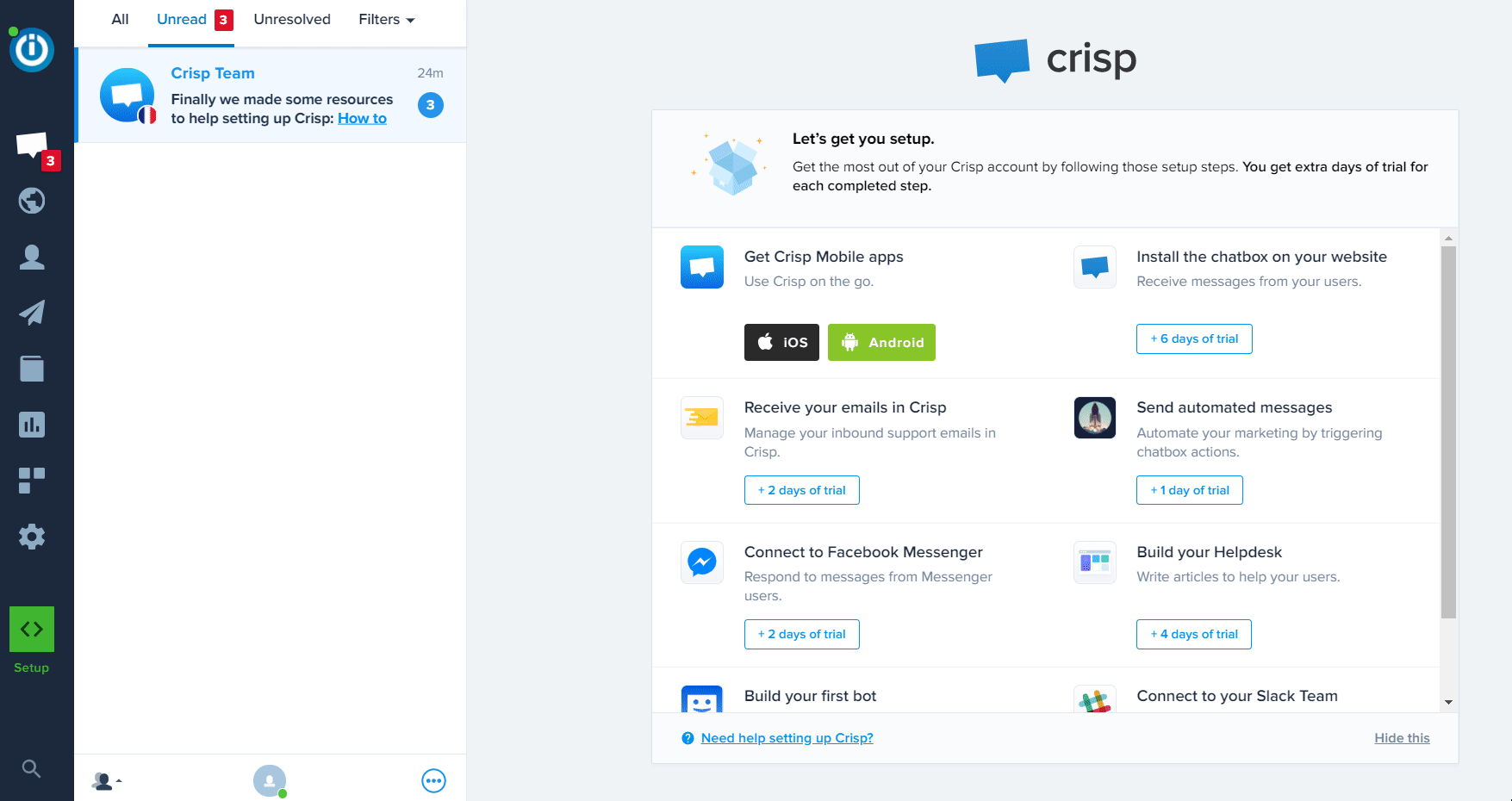| Active with remarks |
|---|
| This application needs additional settings. Please follow the documentation below to create your own connection. |
The Crisp modules allow you to monitor, create, update, send, retrieve, and list the conversations, people, visitors, and websites in your Crisp account.
Prerequisites
-
A Crisp account
In order to use Crisp with Boost.space Integrator, it is necessary to have a Crisp account. If you do not have one, you can create a Crisp account at app.crisp.chat/initiate/signup.
![[Note]](https://docs.boost.space/wp-content/themes/bsdocs/docs-parser/HTML/css/image/note.png) |
Note |
|---|---|
|
The module dialog fields that are displayed in bold (in the Boost.space Integrator scenario, not in this documentation article) are mandatory! |
To connect your Crisp account to Boost.space Integrator you need to obtain the Identifier, Key, and Website ID from your Crisp account and insert it in the Create a connection dialog in the Boost.space Integrator module.
-
Go to the Token Generation website and log in to your Crisp account credentials.
-
Click Generate My API Token.
-
Copy the Identifier and Key details to a safe place.
-
Go to Boost.space Integrator and open the Crisp module’s Create a connection dialog.
-
In theIdentifier and Key fields, enter the token details copied in step 2 respectively.
-
In the Website ID field, enter your website ID for which you want to establish the connection. You can find website ID at Settings > Website Settings > Select the Website > Setup Instructions.
-
Click Continue.
The connection has been established.
Creates a new conversation.
|
Connection |
Search previous Crisp conversations using a search query (an email, username, or word)
|
Connection |
|
|
Search Query |
Enter a keyword or a phrase to search the conversation that matches the specified query. |
|
Search Type |
Select or map the search type for the conversations:
|
|
Include Empty |
Select whether you want to search the empty conversations. |
|
Filter Unread |
Select whether you want to search only the conversations that were not read. |
|
Filter Resolved |
Select whether you want to search only the conversations that were resolved. |
|
Filter Not Resolved |
Select whether to search the conversations that are not resolved. |
|
Filter Mention |
Select whether to search the conversations that mention the current user. |
|
Filter Assigned |
Select whether to search the conversations that were assigned to the current user. |
|
Filter Unassigned |
Select whether to search the conversations that were not assigned to any user. |
|
Filter Date Start |
Enter the date to search the conversations from the specified date. |
|
Filter Date End |
Enter the date to search the conversations until the specified date. |
|
Order By Date Created |
Enter the date to search the conversations that were created on the specified date. |
|
Order By Date Updated |
Enter the date to search the conversations that were updated on the specified date. |
|
Limit |
Set the maximum number of conversations Boost.space Integrator should return during one execution cycle. |
Remove a conversation on the website.
|
Connection |
|
|
Session ID |
Enter (map) the conversation’s Session ID you want to remove. |
Resolves messages in an existing conversation. Returns the last batch of messages if there are many messages in the conversation.
|
Connection |
|
|
Session ID |
Enter (map) the conversation whose messages you want to list. |
|
Before |
Enter (map) the date to list the messages that were created on or before the specified date. |
|
Limit |
Set the maximum number of messages Boost.space Integrator should return during one execution cycle. |
Sends a message in an existing conversation.
|
Connection |
|
|
Session ID |
Enter (map) the conversation Session ID in which you want to send the message. |
|
Message Type |
Select or map the message type and enter the files. For example, |
|
Content |
Enter the message text. |
|
Message Sender |
Select or map the sender to send the message:
|
|
Message Origin |
Select or map the option to send the message:
|
|
Mentioned User Identifier |
Add the users to whom you want to send the message. |
|
Unique Message Fingerprint |
Enter (map) the unique message identifier. This is used to avoid duplicates when using the API as per the real-time sockets. |
|
Type |
Select or map the user type who is sending the message:
|
|
Nickname |
Enter the user’s nickname. |
|
Avatar |
Enter the user’s profile image URL address. |
|
Type |
Select the message type. For example, |
|
Content |
Enter (map) the message data type. |
|
Translated |
Select whether you want to auto-translate the message to the recipient’s choice. |
Resolves an existing message in an existing conversation.
|
Connection |
|
|
Session ID |
Enter (map) the Session ID whose message details you want to retrieve. |
|
Message Fingerprint |
Enter (map) the unique message identifier. This is used to avoid duplicates when using the API as per the real-time sockets. |
Edits an existing message in an existing conversation.
|
Connection |
|
|
Session ID |
Enter (map) the Session ID whose message details you want to retrieve. |
|
Message Fingerprint |
Enter (map) the unique message identifier. This is used to avoid duplicates when using the API as per the real-time sockets. |
|
Message Type |
Select or map the message type and enter the details for the dynamic fields:
|
Adds a new people profile.
|
Connection |
|
|
|
Enter the people’s profile’s email address. |
|
Full Name |
Enter the user’s full name. |
|
Avatar URL |
Enter (map) the user’s profile image URL address. |
|
Gender |
Select or map the gender of the user. |
|
Phone Number |
Enter (map) the user’s phone number. |
|
User Address |
Enter (map) the user’s address. |
|
User Website |
Enter (map) the user details. |
|
Timezone |
Enter (map) the user’s timezone. |
|
Profiles |
Add the profiles: Profile Type Enter (map) the user profile type. For example, Handle Enter (map) the handle for the user profile. Profile URL Enter (map) profile URL address. For example, |
|
Company Name |
Enter (map) the user’s company name. |
|
Company Domain Name |
Enter (map) the user’s company domain name. |
|
User Title |
Enter (map) the user title. For example, |
|
User Role |
Enter (map) the user’s role. For example, |
|
User Seniority |
Enter (map) the user’s seniority in the company. For example, |
|
Country Code |
Enter (map) the two-character country code where the user is located. For example, |
|
Region Code |
Enter (map) the region code where the user is located. For example, |
|
City Name |
Enter (map) the city name where the user is located. For example, |
|
Latitude |
Enter (map) the user’s location latitude details. |
|
Longitude |
Enter (map) the user’s location longitude details. |
|
Locales |
Enter (map) the two-character locales preferred language code. For example, |
|
Company Name |
Enter (map) the user’s company name. |
|
Company Legal Name |
Enter (map) the user’s company’s legal name. |
|
Company Domain Name |
Enter (map) the user’s company domain name. |
|
Company Website URL |
Enter (map) the user’s company’s website URL address. |
|
Company Description |
Enter (map) the user’s company description details. |
|
Company Timezone Offset |
Enter (map) the user’s company timezone offset. |
|
Company Phones |
Enter (map) the user’s company phone numbers. |
|
Company Emails |
Enter (map) the user’s company’s contact email addresses. |
|
Country Code |
Enter (map) the two-character country code where the user’s company is located. For example, |
|
Region Code |
Enter (map) the region code where the user’s company is located. For example, |
|
City Name |
Enter (map) the city name where the user’s company is located. For example, |
|
Latitude |
Enter (map) the user’s company’s location latitude details. |
|
Longitude |
Enter (map) the user’s company’s location longitude details. |
|
Number of Employees |
Enter (map) the number of employees in the company. |
|
Market Capitalization |
Enter (map) the company’s market capitalization cap. |
|
Money Raised |
Enter (map) the amount company raised in the form of investment. |
|
Annual Recurring Revenue |
Enter (map) the company’s annual recurring revenue. |
|
Tags |
Add the tags for the user. |
|
Segments |
Add the segments for the user. For example, |
|
Private Notepad |
Enter (map) the private notepad details of the user. |
Updates people profile, and save only changed fields on the previous profile revision.
|
Connection |
|
|
People ID |
Select or map the People ID whose details you want to update. |
|
|
Enter the people’s profile’s email address. |
|
Full Name |
Enter the user’s full name. |
|
Avatar URL |
Enter (map) the user’s profile image URL address. |
|
Gender |
Select or map the gender of the user. |
|
Phone Number |
Enter (map) the user’s phone number. |
|
User Address |
Enter (map) the user’s address. |
|
User Website |
Enter (map) the user details. |
|
Timezone |
Enter (map) the user’s timezone. |
|
Profiles |
Add the profiles: Profile Type Enter (map) the user profile type. For example, Handle Enter (map) the handle for the user profile. Profile URL Enter (map) profile URL address. For example, |
|
Company Name |
Enter (map) the user’s company name. |
|
Company Domain Name |
Enter (map) the user’s company domain name. |
|
User Title |
Enter (map) the user title. For example, |
|
User Role |
Enter (map) the user’s role. For example, |
|
User Seniority |
Enter (map) the user’s seniority in the company. For example, |
|
Country Code |
Enter (map) the two-character country code where the user is located. For example, |
|
Region Code |
Enter (map) the region code where the user is located. For example, |
|
City Name |
Enter (map) the city name where the user is located. For example, |
|
Latitude |
Enter (map) the user’s location latitude details. |
|
Longitude |
Enter (map) the user’s location longitude details. |
|
Locales |
Enter (map) the two-character locales preferred language code. For example, |
|
Company Name |
Enter (map) the user’s company name. |
|
Company Legal Name |
Enter (map) the user’s company’s legal name. |
|
Company Domain Name |
Enter (map) the user’s company domain name. |
|
Company Website URL |
Enter (map) the user’s company’s website URL address. |
|
Company Description |
Enter (map) the user’s company description details. |
|
Company Timezone Offset |
Enter (map) the user’s company timezone offset. |
|
Company Phones |
Enter (map) the user’s company phone numbers. |
|
Company Emails |
Enter (map) the user’s company’s contact email addresses. |
|
Country Code |
Enter (map) the two-character country code where the user’s company is located. For example, |
|
Region Code |
Enter (map) the region code where the user’s company is located. For example, |
|
City Name |
Enter (map) the city name where the user’s company is located. For example, |
|
Latitude |
Enter (map) the user’s company’s location latitude details. |
|
Longitude |
Enter (map) the user’s company’s location longitude details. |
|
Number of Employees |
Enter (map) the number of employees in the company. |
|
Market Capitalization |
Enter (map) the company’s market capitalization cap. |
|
Money Raised |
Enter (map) the amount company raised in the form of investment. |
|
Annual Recurring Revenue |
Enter (map) the company’s annual recurring revenue. |
|
Tags |
Add the tags for the user. |
|
Segments |
Add the segments for the user. For example, |
|
Private Notepad |
Enter (map) the private notepad details of the user. |
Removes people’s profiles on the website.
|
Connection |
|
|
People ID |
Select or map the People ID you want to delete. |
Lists people profiles for the website.
|
Connection |
|
|
Sort Order |
Select or map the order in which you want to sort the profiles. |
|
Search Text |
Enter the text or keyword to search the profiles that match the specified query. |
|
Filter From |
Enter (map) the date to list the profiles that were created from the specified date. |
|
Filter Until |
Enter (map) the date to list the profiles that were created until the specified date. |
|
Limit |
Set the maximum number of people profiles Boost.space Integrator should return during one execution cycle. |
Counts visitors currently on the website.
|
Connection |
Lists visitors currently on the website.
|
Connection |
|
|
Limit |
Set the maximum number of visitors Boost.space Integrator should return during one execution cycle. |
Checks if a given website exists (by domain)
|
Connection |
|
|
Domain |
Enter (map) the domain which you want to check if it exists. |
Resolves existing website information.
|
Connection |
Creates a new website.
|
Connection |
|
|
Website |
Enter the website name. |
|
Domain |
Enter the website domain name. for example, integromat.com |
Deletes an existing website.
|
Connection |
|
|
Password |
Enter your Crisp account password to delete the website. |
Performs an arbitrary authorized API call.
|
Connection |
|
|
URL |
Enter a path relative to For the list of available endpoints, refer to the Crisp API Documentation. |
|
Method |
Select the HTTP method you want to use: GET to retrieve information for an entry. POST to create a new entry. PUTto update/replace an existing entry. PATCH to make a partial entry update. DELETE to delete an entry. |
|
Headers |
Enter the desired request headers. You don’t have to add authorization headers; we already did that for you. |
|
Query String |
Enter the request query string. |
|
Body |
Enter the body content for your API call. |
The following API call returns all the conversations from your Crisp account:
URL:
/v1/website/{website_id}/conversations
Method:
GET
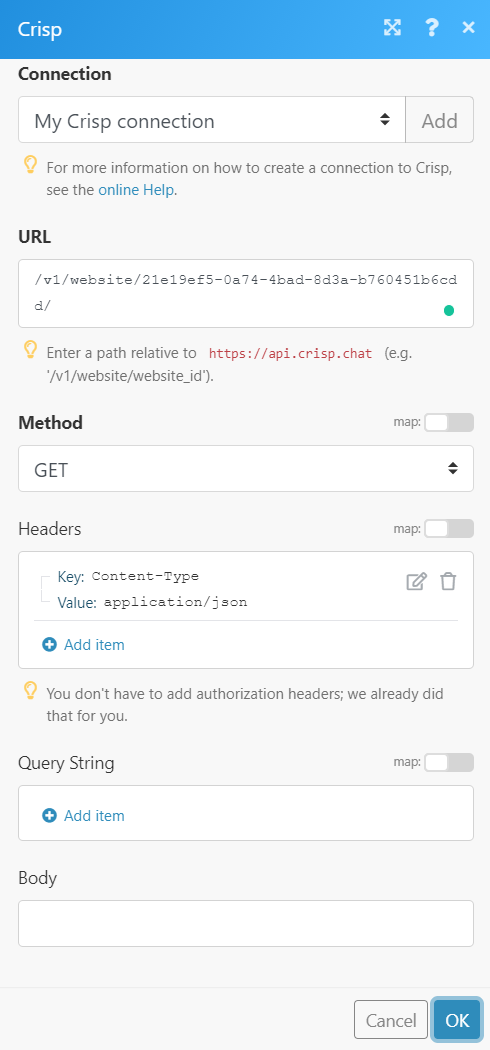
Matches of the search can be found in the module’s Output under Bundle > Body > data.
In our example, 1 conversation was returned:
